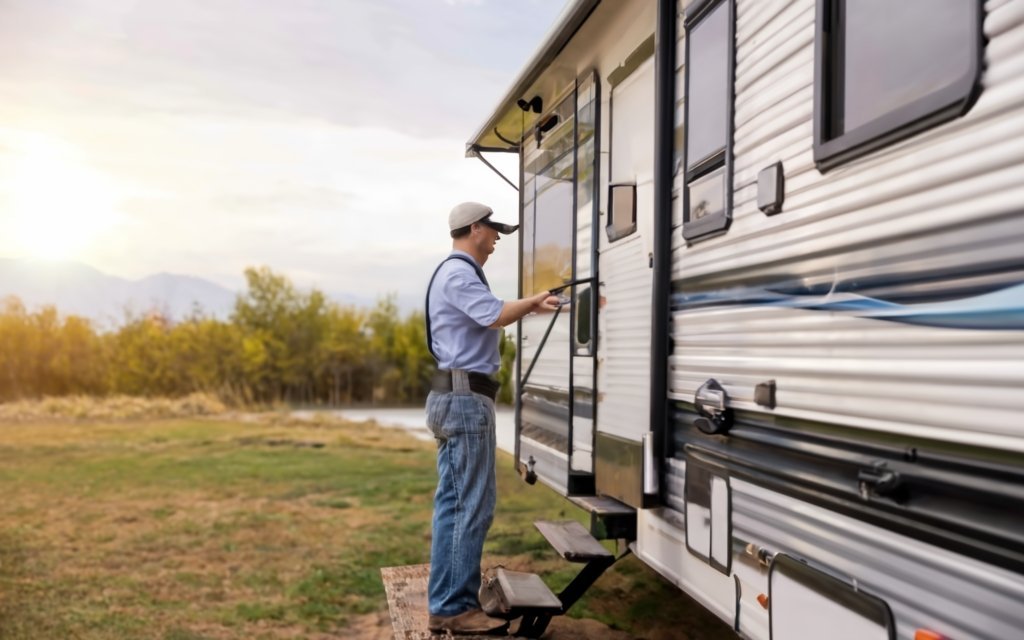A dripping RV air conditioner is not ideal and can point to various issues. Here are some possible reasons why your RV AC might be dripping water inside:
Clogged drain pan: The most common culprit is a clogged drain pan. This pan collects condensation from the evaporator coils and should drain out through a small hole. If the hole is blocked by dirt, leaves, or debris, the pan can overflow and leak water inside.
Damaged drain pan: Cracks or holes in the drain pan can also cause leaks.
Loose drain tube: The drain tube connects the pan to the exterior of the RV. If it’s loose or disconnected, water can leak back into the unit and drip inside.
Improper leveling: If your RV isn’t leveled properly, the condensate won’t drain efficiently, increasing the risk of overflow.
Evaporator coil issues: In some cases, ice buildup on the evaporator coil can block the drain pan and cause leaks. This is more likely if your air filter is dirty or the refrigerant level is low.
Seal issues: Leaks can also occur around the seals between the air conditioner and the roof of the RV.
Here’s what you can do to troubleshoot the problem:
- Clean the drain pan: Start by clearing any debris from the drain pan and the drain hole. You can use a long, thin object like a bottle cleaner or wire to poke through the hole and clear any blockages.
- Check the drain tube: Make sure the drain tube is properly connected and not kinked.
- Check the leveling: Ensure your RV is leveled to allow proper drainage.
- Clean the air filter: A dirty air filter can restrict airflow and lead to ice buildup on the evaporator coil. Clean or replace the air filter regularly.
- Look for damage: Inspect the drain pan and seals for any cracks or holes.
If you’re not comfortable troubleshooting the problem yourself, or if the issue persists, it’s best to consult a qualified RV technician. They can diagnose the specific problem and make any necessary repairs.
Here are some additional tips:
- Keep the roof of your RV clean: This will help prevent debris from entering the air conditioner.
- Don’t block the air vents: Blocking the air vents can restrict airflow and contribute to ice buildup on the evaporator coil.
- Shut off the AC when not in use: This will help prevent ice buildup from forming overnight.
Hopefully, this information helps you identify and fix the leak in your RV air conditioner. Remember, if you’re unsure about anything, it’s always best to consult a professional. Another article that you should read about RVs is >>>>> Why Does My RV Air Conditioner Smell Musty? and Why Does My RV Keep Tripping the Breaker? to learn more.
1: Understanding the A/C and Moisture – The Science Behind the Drips.
Ah, the rhythmic tap-tap-tap on the ceiling. The dreaded damp patch blossomed on the wall. Yep, your RV’s AC has gone rogue, and it’s playing monsoon inside your rolling haven. Been there, soaked a towel there. But before you panic-book a mobile mechanic, let’s demystify the magic of RV air conditioning and understand the watery foes lurking within.
The Cool Down Cycle: Picture this: hot, sticky air enters your AC. It passes over chilly evaporator coils, magically transforming into refreshing coolness. But here’s the catch: just like a cold glass sweating on a humid day, those coils produce condensation, a fancy word for tiny water droplets.
Drain Pan to the Rescue: Thankfully, nature’s little waterworks don’t flood your floor. Enter the drain pan, a trusty catch basin nestled beneath the coils. This unsung hero collects the condensation, channeling it through a drain tube out to the great RV beyond.

Foes of Flow: But like any good adventure, things can get tricky. Meet the villains of proper drainage:
- Clogged Drain: Dust, leaves, even rogue insects – can plug the drain pan like a stubborn sink, leading to overflow and drips.
- Faulty Seal: Cracked gaskets around the air conditioner unit or a loose drain tube connection can also create sneaky leakage pathways.
- Leveling Woes: An uneven RV throws the whole system off balance, causing condensation to pool and potentially overflowing.
Beyond Basic Drips: Sometimes, the leak plot thickens. Here are some rarer culprits:
- Ice Buildup: Neglected air filters or low refrigerant levels can lead to icy evaporator coils, blocking the drain and causing meltwater mayhem.
- Refrigerant Leaks: This one calls for immediate professional help. Leaky refrigerant lines, although uncommon, can pose health and safety risks.
- DIY Mishaps: Let’s face it, we’ve all been there. A well-intentioned attempt at a quick fix might have accidentally created a new leak.
Part 2: Identifying the Leak – Sherlock Holmes in Your RV.
Okay, detective mode activated! Let’s pinpoint the source of those unwelcome drips. Remember, location is key:
- Ceiling Drips Likely culprits – faulty seals, leaky vent covers, or even roof leaks unrelated to the AC.
- Wall Drips: Check the interior unit for loose drain pan connections or cracks near the vents.
- Floor Drips: The drain pan overflows or the drain tube might be disconnected or leaking.
Visual Inspection: Grab a flashlight, channel your inner CSI, and investigate:
- Look for drips, cracks, and loose parts around the AC unit, both inside and out.
- Check the drain pan for debris and ensure it’s level and not overflowing.
- Follow the drain tube to its exit point, making sure it’s firmly connected and free of kinks.
Sound & Smell Check: Sometimes, subtle hints can crack the case:
- Gurgling noises near the drain pan often indicate a clog.
- A musty odor might point to mold growth due to trapped moisture.
Remember: This is just the beginning of our leak-busting adventure. Stay tuned for Part 3, where we’ll tackle DIY fixes, pro-help advice, and preventative measures to keep your RV cool and dry!
Table 1: Common Leak Locations and Possible Causes
| Leak Location | Possible Causes |
|---|---|
| Ceiling | Faulty seals, leaky vent covers, roof leaks |
| Wall | Loose drain pan connections, cracks near vents |
| Floor | Drain pan overflow, disconnected or leaking drain tube |
Bullet Points: RV AC Leak Essentials
- Condensation is normal, but proper drainage is key.
- Clogs, leaks, and uneven leveling are common drip instigators.
- The location of the drips can offer clues to the source.
- Visual inspection and sound checks are your detective tools.
- Stay tuned for DIY fixes and pro help tips!
Part 3: Fixing the Problem – From DIY Hero to Master Mechanic.
Alright, folks, we’ve identified the leak, now it’s time to banish those pesky drips! But remember, adventurer, choose your weapon wisely. Some battles are best-fought solo, while others require calling in the cavalry (aka professional RV technicians).
DIY Warriors, Assemble!
- Clogged Drain Pan: Grab a long, thin tool like a bottle cleaner and gently unclog the drain hole. Flush the pan with clean water to ensure smooth drainage.
- Loose Connections: Tighten any loose screws or clamps, particularly around the drain pan and drain tube.
- Leveling Woes: Time to whip out that trusty leveling tool (or even a handy smartphone app!) and get your RV back to equilibrium.
Intermediate Repairs for the Brave:
- Drain Tube Replacement: A kinked or damaged tube needs a heroic replacement. Invest in a new tube and follow the existing route for a hassle-free swap.
- Resealing the Vent Cover: Gasket malfunctioning? No problem! Grab some RV-specific sealant and apply it around the vent cover for a watertight seal.
When to Call the Pros:
- Electrical Woes: Anything involving wiring or electrical components, especially refrigerant leaks, is strictly out of bounds for DIY. Leave it to the certified masters.
- Complex Repairs: Cracked drain pans, faulty seals requiring disassembly, or major refrigerant issues – call in the pros to save yourself time and potential headaches.
Part 4: Preventative Measures – Keep Your Cool, Inside and Out.
Don’t let the drip drama repeat! Be proactive and keep your cool (literally) with these preventative measures:
- Maintenance Matters: Clean the air filter regularly and schedule annual inspections of the evaporator coils to prevent ice buildup and clogs.
- Smart Camping Habits: Turn off the AC when not in use, avoid blocking air vents, and keep the roof clean to prevent debris from entering the system.
- Bonus! RV AC Upgrades: Consider rain covers for extra protection, automatic leveling systems for effortless balance, and moisture control devices for an extra layer of defense.

Remember: Knowledge is power, and preparedness is your best weapon against future leaks. Now, go forth, adventurers, and conquer those watery foes! Let your RV remain a haven of cool comfort, ready for your next epic journey.
Conclusion: Conquering the Drips and Embracing Adventure Anew.
Ah, the saga of the leaky RV AC – a tale many adventurers know too well. But fear not, fellow explorers! Armed with the knowledge in this guide, you are now equipped to diagnose, fix, and ultimately prevent those unwelcome drips. Remember, some battles are best-fought solo with a bit of DIY spirit, while others call for the cavalry of skilled professionals. No matter the foe, however, the key lies in proactive maintenance, smart habits, and a touch of adventurous preparedness.
So, go forth and conquer, with confidence that your rolling haven remains a cool and dry oasis amidst any journey. Let the rhythmic tap-tap-tap of rain be the only water music in your RV, a reminder of the adventures waiting just beyond the window. Happy travels, and may your AC always bring the chill, without the spill!
Final Tips:
- Bookmark this guide for future reference – a trusty companion on your RV escapades.
- Share your expertise – spread the word to fellow adventurers and help them keep their cool the right way.
- Never stop exploring – the open road awaits, with fresh air and countless stories to be written, drip-free!

Welcome to the enchanting world of Genah Reney, the esteemed Author-in-Residence at BAF TOURS International. Genah is not only a master storyteller but also a guiding force in weaving narratives that elevate the travel experience. Her literary prowess mirrors the essence of BAF TOURS, creating a seamless blend of captivating stories and the allure of global exploration.






